 |  | ||||
| |||||
By a Hair
Installation by Karen Jordon curator Petra Halkes Karen Jordon 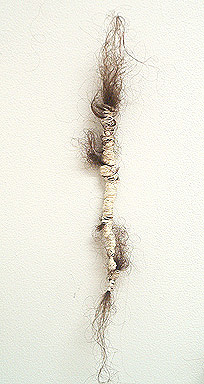 By A Hair, single work, Hair & Twine, 2003, Karen Jordon PRESS RELEASE FOR BY A HAIR BY KAREN JORDON By a Hair: An Installation by Karen Jordon
PETRA HALKES - CURATORIAL STATEMENT for BY A HAIR By a Hair: An Installation by Karen Jordon Ever the keeper of things once held close to the body but no longer wanted-- worn-out shoes, handbags, dresses and such-- Jordon began to collect the bouncy hair about eight years ago. In what originally may have been an act of revenge, a taming of the curls, she wrapped individual locks with white cotton string, tightly. The wild curls were transformed into a myriad of capricious abstract shapes, and her everyday problem was sublimated into art. The hundreds of sculptural objects seen at the offthemapgallery are not arranged chronologically. Rather, the artist creates interesting juxtapositions of older and recent pieces. A new relationship is set up between the hair and Jordon, one that relies on concessions rather than on control. It is true that the hair has lost some power; tufts peek out from limb-like wrappings or dangle from their ends. But Karen’s sensitive tracing of the hair’s determined curliness shows a wonder and respect for its organic forms. The artwork manifests a process of give-and-take rather than control. Once initiated, there seemed no reason to stop this ritual of art making as long as the hair kept falling out. And so the hair sculptures became signs of life, documenting Jordon’s life cycle. Every new wrapping that is created provides evidence that her death is once again kept at bay, if only by a hair. Jordon’s curls look nothing like the softly undulating long tresses that garner the highest appreciation in our society. Just think of the models in shampoo commercials who fling their hair like sheets in the wind. In one commercial for a "nature" shampoo, a woman who washes her hair in a gas station’s washroom reaches orgastic ecstasy. She then steps out smiling at the befuddled attendant, tossing her long hair from side to side. Could one imagine this woman stepping out of the washroom with an up-and-away bush of curls? If long flowing hair is "natural" for a woman, the equation of woman with nature is but an extension of this idea. The ideal feminine hair resembles ripples of a creek, waves of grasses and undulating sand dunes, all passive images of a natural landscape shaped by the wind. Symbolist painters of the 19th century did much to further the "woman-is-nature" stereotype. John Millais painted Ophelia (1851-52) floating down the river, her hair fanning out around her face, rippling in the water. She is an alluring beauty, who, in all her madness and passivity seems there for the taking, just like nature is thought to be. A different kind of beauty arises from Jordon’s rows and rows of hair sculptures, painstakingly put together bit by bit, in the treasured free moments of a busy woman’s life. There is no free flow here, there are no wind-whipped waves. Instead, there are the hands and the string, tying, connecting, inhibiting the hair. It is in the persistence of these inhibitions, echoing the realities of a woman’s life, that a new beauty begins to appear: handmade, self-fashioned, tough. -Petra Halkes 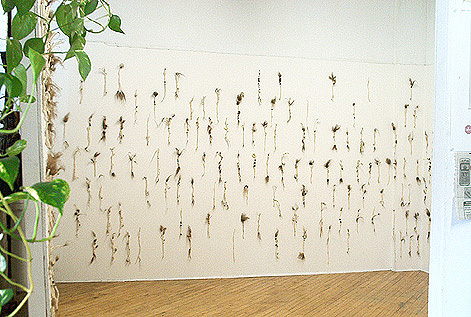 By A Hair, installation view, Hair & Twine, 2003, Karen Jordon 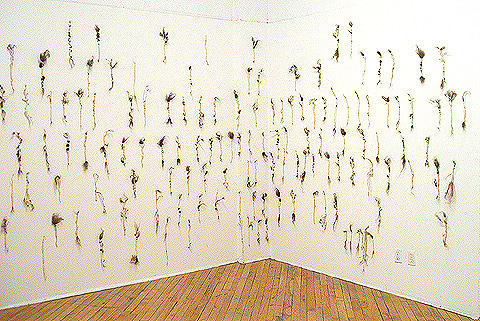 By A Hair, installation view, Hair & Twine, 2003, Karen Jordon 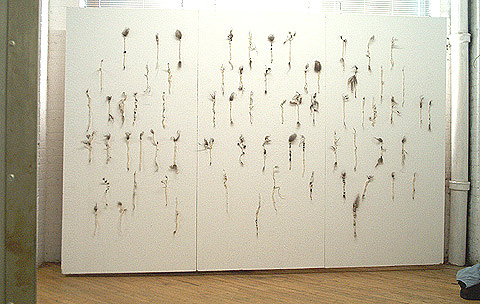 By A Hair, installation view, Hair & Twine, 2003, Karen Jordon 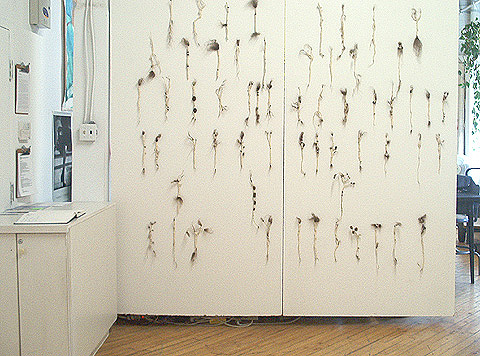 By A Hair, installation view, Hair & Twine, 2003, Karen Jordon 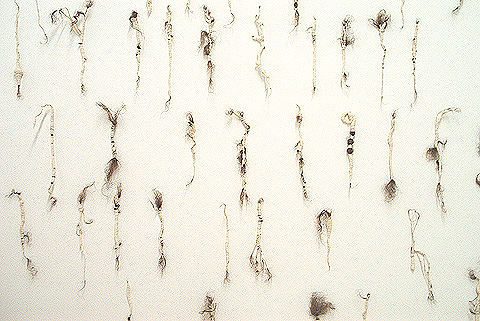 By A Hair, installation view, Hair & Twine, 2003, Karen Jordon 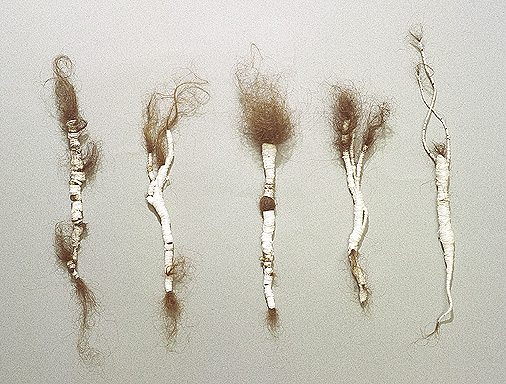 By A Hair, installation detail, Hair & Twine, 2003, Karen Jordon | |||||
 |  | ||||
 |  | ||||
 |  | ||||
 |  | ||||
 |  | ||||
 |  | ||||